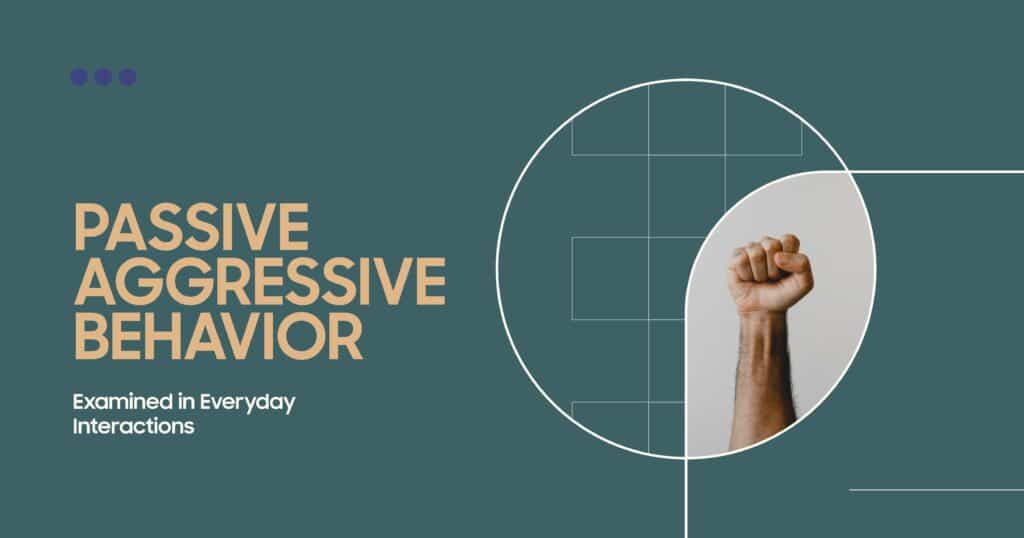In everyday life, it is usual to experience behaviors that seem confounding, irritating, or dismissive but not overtly antagonistic. This tendency of not solving the problems directly but through retreat has commonly been referred to as passive-aggressive behavior.
It may undermine trust, communication, and emotional well-being in the long term, whether it manifests itself in personal relationships, at work, or even in casual social encounters. To have healthier and more genuine interactions, it is important to know what it is, why it happens, and how to avoid it in the future.
Defining Passive-Aggressive Behavior
Passive-aggressive behavior is the expression of negative feelings, resentment, or hostility in an unclear way. The person does not express their dissatisfaction – instead, they use passive methods of communication that conceal real intentions. Passive aggression is concealed in a veil of compliance or courtesy, while overt aggression is straightforward and aggressive.
Examples may include agreeing to do something but intentionally postponing the task, making backhanded compliments that are insulting to another person, or even giving the silent treatment as a form of punishment without mentioning any conflict. This evasive action is hurtful when it substitutes candid communication, which generates perplexity and strain in relations.
Psychologists observe that passive aggression is usually caused by an inability to express anger openly, fear of confrontation, or the way one was raised in childhood, where expressing disagreement openly was not acceptable. Rather than facing the problems that come in their way, people end up using veiled critique or underhanded intentiones to express their displeasure.
Treat Mental Health Texas
Common Signs of Passive-Aggressive Actions
Passive aggression cannot always be noticed. It can be disguised as politeness, forgetfulness, or humor, but in the background, there is a history of hidden aggressiveness. The identification of such patterns will assist in dealing with them.
Verbal Indicators
Words often convey more than they actually say. The following are examples of verbal cues of passive-aggressive behavior:
- Backhanded Compliments. Compliments that appear to be very complimentary but include some subtle insults.
- Disguised Criticism. An act of claiming to make a judgment as an act of giving advice or concern, when the intention is to put down.
- Latent Sarcasm. Use of humor as a disguise for annoyance or indignation.
- Evasive Responses. When one answers a question to avoid responsibility.

Non-Verbal Cues
The non-verbal signs of passive aggression are also very important. These actions may speak louder than words:
| Non-Verbal Cue | Meaning in Context |
| Silent treatment | Withdrawal of communication to exert control or express disapproval. |
| Eye rolling | Displays dismissiveness without verbal confrontation. |
| Procrastination | Deliberate delay of tasks as a form of resistance. |
| Avoidance | Refusing to engage with certain people or topics to signal discontent. |
| Sighing heavily | Expressing annoyance indirectly instead of stating feelings openly. |
Together, these verbal and non-verbal elements create an atmosphere of confusion, leaving others unsure of how to respond or resolve conflict.
The Psychology Behind Passive Aggression
In order to get a full picture of what passive-aggressive behavior is all about, it is essential to examine the psychology behind it. Passive aggression is usually supported by the fact that one is not able to express negative emotions openly. The fear of rejection, cultural norms that do not allow open confrontation, or childhood experiences where disagreement was penalized all lead to the formation of passive communication styles.
According to psychologists, those who resort to indirect types of behavior can also feel inner conflict – they are angry or displeased but afraid of the punishment of being openly expressive. This causes strain, leading them to use non-verbal communication or passing remarks as a temporary measure.
To obtain more information on the origins of communication styles, The National Institute of Mental Health offers educational resources on emotional regulation and behavioral patterns.
Treat Mental Health Texas
Impacts of Passive-Aggressive Behavior on Relationships
Passive aggression in relationships is very destructive. A lack of honest communication leads to erosion of trust, and misunderstandings are multiplied.
Effects on Personal Relationships
Emotional distance is a result of underlying hostility in personal relationships. An example of this is the silent treatment, where isolation rather than resolution is established. Partners or friends can have a sense of being sidelined or disapproved, while those who engage in the action usually believe they are not understood. Both parties develop resentment over time. Disguised criticism or backhanded compliments can also negatively affect self-esteem, and mistrust may develop, leading to an unhealthy relationship.
Workplace Challenges
Passive aggression is particularly destructive in the workplace since it interferes with the productivity and collaborative effort. Projects are negatively affected when the employees procrastinate on purpose, provide low-key sabotage, or withhold information. Supervisors can also be indirect in their behavior, providing vague feedback instead of constructive criticism, so confusing the employees on the expectation. These difficulties not only demoralize employees, but they might also increase turnover.
The Harvard Business Review confirms that organizations thrive when communication is transparent. Passive aggression does this by generating a situation in which problems brew rather than coming out openly.
Strategies for Addressing Passive-Aggressive Behavior
Passive-aggressive patterns are difficult but can be addressed through awareness and conscious effort. The strategies promote openness and accountability to both individuals and groups.
Approaches for Individuals
In case you are the actor or victim of passive aggression, the following are some of the effective steps:
- Recognize the Behavior. The initial approach to change is acknowledging the signs of indirect behavior.
- Practice Direct Communication. Be open-hearted about emotions and use statements to lessen the level of defensiveness.
- Boundaries: When a person communicates through the silent treatment or little sabotage, explain what you expect as a result of communication.
- Get Some Help. Therapy and counseling will help offer resources on how to deal with anger and express emotions in ways that are healthier.
Techniques for Conflict Resolution
When there is conflict, one should avoid escalation but should fight the cause:
- Keep Your Head. Hostility is a vicious cycle that is maintained by aggression.
- Clear Up Meanings. Inquire to find out the meaning of ambiguous or confusing statements.
- Model Directness. Be open to communication, and that will establish a healthier interaction.
- Use Mediation When Necessary. Third-party mediation can be used in the workplace or family environment to conduct productive dialogue.
These interventions provide a basis for abandoning passive communication in favor of openness and trust.
Treat Mental Health, Texas: Support for Healthier Communication and Relationships
It is tiring to deal with passive-aggressive conduct, and a professional can offer counsel and relief. At Treat Mental Health Texas, our staff members also collaborate with individuals, couples, and families to substitute unhealthy indirect communication with direct and compassionate communication.
During therapy and counseling, the clients are taught to identify such patterns as the silent treatment, the backhanded compliments, or the micro-sabotaging, and, instead, are taught how to use the means of genuine connection.
If you or a loved one exhibits passive-aggressive behavior, it should not be allowed to ruin your relationships. Call now to find healthier and safer ways of communicating and regaining trust. Get in touch with Treat Mental Health Texas to start building better and happier relationships.

Treat Mental Health Texas
FAQs
What are some common non-verbal cues that indicate passive-aggressive behavior?
The most common example of nonverbal cue that shows passive-aggressive behavior includes silent treatment, procrastination, eyes rolling. All of these signal discontent indirectly. Such cues express frustration without addressing the underlying situation.
How does silent treatment function as a tool for underlying hostility in passive communication?
Silent treatment involves denying affection or talking and leaving the other person alone. It expresses anger or resentment but does not confront it.
In what ways can disguised criticism manifest in indirect behavior?
Disguised criticism is mostly passed down as sarcastic jokes, unsolicited advice, or remarks of just kidding. The criticism is disguised with politeness or humor, yet it is hostile.
How can backhand compliments serve as a form of subtle sabotage in relationships?
Backhanded compliments can sound flattering, but there is an insult in them, e.g. you look good despite your age. Such a comment negates confidence and destroys trust.
What strategies can help address passive-aggressive behavior effectively without escalating tension?
Direct communication can be modeled, boundaries established, and can be done calmly as an effective solution. Therapy can also equip one with mechanisms of dealing with conflict in constructive ways.










